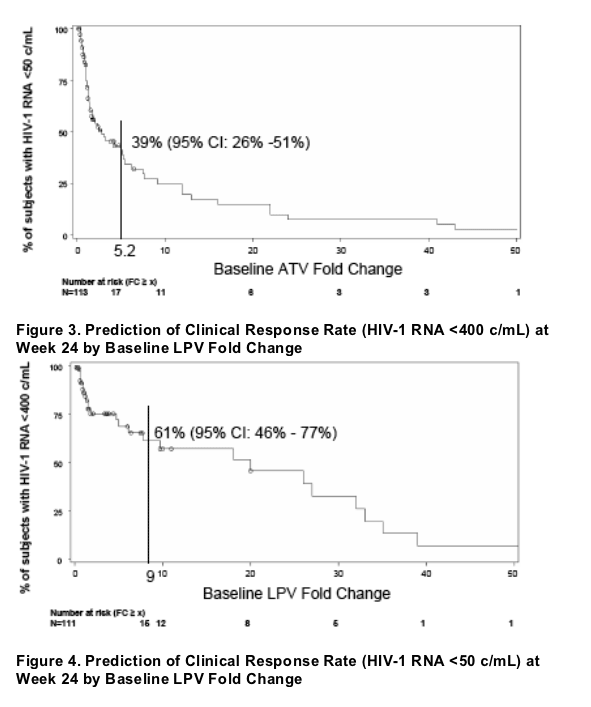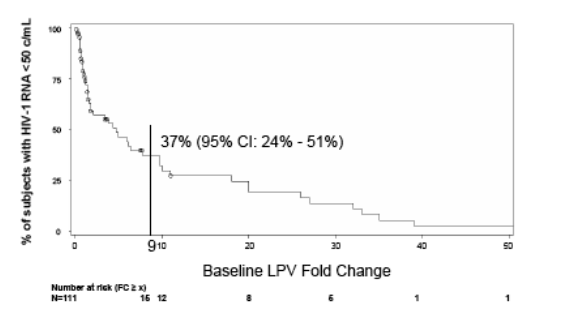 |
 |
 |
| |
Prediction of Reyataz Clinical Response Rate by Phenotypic Fold Change Using Kaplan-Meier Estimate in the AI424-045 Study
|
| |
| |
Reported by Jules Levin
16th Intl HIV Drug Resistance Workshop, June 12-16, 2007, Barbados
Daniel Seekins1, Jen-Fue Maa1
1Bristol-Myers Squibb, Plainsboro, NJ, USA
AUTHOR DISCUSSION
Categorical analyses, typically performed in the determination of clinical cutoffs, have a limited ability to precisely estimate the response rates due to sparse high fold change data. The selection of categories is often subjective.
Other prediction models such as logistic regression have limited ability to precisely predict the response rate for fold change at the extremes of high and low fold change values because the prediction accuracy decreased severely when the probability is near 0 or 100 percent [4].
The Kaplan-Meier method provides more detailed estimates of treatment response rate at high and low fold change. It also provides more granular estimates than the observed response rate calculated by grouping data in several fold change intervals.
Potentially, the survival analysis approach described currently could be extended to multivariate methods, such as the Cox-proportional hazard model, and be used to incorporate factors associated with treatment failure, including baseline fold change as a covariate.
Caveats: values at high fold change should be interpreted with caution as the number of subjects with high fold change is small. A confirmation from a large data base and various different studies is recommended. The robustness of all of the methods depend upon sufficient numbers of virologic failures observed.
AUTHOR CONCLUSIONS
The Kaplan-Meier method provides a detailed and simplified way of predicting the clinical response rate.
The probability of clinical response assessed by Kaplan-Meier method using baseline phenotypic data provides clinicians a continuous assessment tool that may be useful in guiding treatment decisions.
INTRODUCTION
Clinical cutoffs are important in allowing clinicians to properly interpret phenotypic resistance data and select active regimens for their patients [1].
Conventional analysis of clinical response rates by fold change typically involves grouping by certain fold change intervals and calculation of the response rate within those intervals. The limitation of this method is that available data are usually sparse at high fold change levels. This limits the ability of the method to characterize the relationship between treatment failure rate and baseline fold change and provide precise estimates for clinical response rates at high fold change levels.
An application of the Kaplan-Meier (K-M) method to characterize the continuous relationship between baseline phenotype measured by fold change and clinical response rates was performed in this analysis.
METHODS
AI424-045 was a randomized, open-label, multinational study. Subjects were enrolled in the study with detectable viral load following treatment failure. Subjects failed at least two prior regimens including at least one drug from each of the NRTI, NNRTI, and PI classes, with a median prior PI exposure of
2.6 years.
Baseline phenotype (HIV PhenoSense, Monogram Biosciences) and plasma HIV-1 RNA (Roche Molecular System V1.5) were used to measure fold change and viral load (VL).
Kaplan-Meier methodology provides a continuous estimate of the survival probability across time. The model tested uses this mathematical advantage to describe a continuous relationship between clinical response rates and fold change by replacing the time variable with the baseline fold change value.
The following are the elements of the K-M analysis in this study:
--Event/censor: when a virologic failure was observed/or not
--Treatment failure: defined as failure to achieve a viral load below the limit of detection (<50, or < 400 copies/mL) evaluated at the single timepoint at Week 24
--X-axis: use fold change as the x-axis in the survival analysis instead of time
In a traditional K-M survival analysis, a subject is censored if no event (death/failure) occurs at or prior to the last time point observed in a study. In our fold change survival analysis, a subject is censored if a viral load at Week 24 was still suppressed.
Consistent with several previous clinical cutoff analyses, Week 24 was selected as the virologic failure endpoint since it is temporally close enough to baseline to reflect the impact of baseline fold change on viral response yet sufficient to allow
assessment of response to treatment. Previously, the clinical cutoff analyses for ATV/r using responses at Week 2 and at Week 24 were demonstrated to be concordant [2]. Subject dropouts due to non-efficacy related reasons prior to Week 24 were excluded from this analysis.
RESULTS
In the 045 study, 358 subjects were randomized with mean age 41 years, 78% male, 60% white, 22% Hispanic, 15% black, and 6% IV drug users. The mean HIV-1 RNA was 4.4 log10 copies/mL and mean CD4 was 337 cells/mm3. Of these subjects,113 and 111 treated subjects were evaluable in this analysis with Mean±SD baseline HIV-1 RNA of 4.5±0.74 and 4.5±0.78 log10 copies/mL for ATV/r and LPV/r arms, respectively. Median (Q1-Q3 and min-max) baseline fold change was 1.1 (0.6-2.7, 0.2-57) and 0.9 (0.6-3.4, 0.2-64) for ATV/r and LPV/r arms, respectively.
There were 35 and 29 subjects who failed (did not achieve VL<400 copies/mL at Week 24) and 60 and 52 subjects who failed (did not reach VL<50 copies/mL at Week 24) for ATV/r and LPV/r arms, respectively.
The Kaplan-Meier curve for clinical response rate continued to decrease as fold change increased for both VL ≥400 and VL ≥50 analyses. In the Kaplan-Meier analysis, mean±SE fold changes for VL ≥400 copies/mL were 14.1±3.0, and 18.7±2.6 for ATV/r and LPV/r arms, respectively. Mean±SE fold change for the VL ≥50 c/mL was 8.5±1.8, and 10.4±1.8 for ATV/r and LPV/r arms, respectively.
The current fold change clinical cutoff for the PhenoSense assay is 5.2 for ATV/r and 9 for LPV/r [3]. By using these cutoffs, the predicted clinical response rates by Kaplan-Meier method for VL <400 copies/mL are 62% (95%CI 48%-76%)
and 61% (95%CI 46%-77%) for ATV/r and LPV/r arms, respectively. The predicted clinical response rates by Kaplan-Meier method for VL <50 c/mL are 39% (95%CI 26%-51%) and 37% (95%CI 24%-51%) for ATV/r and LPV/r arms, respectively.
Table 1 lists the results of categorical analyses for the % of subjects with HIV-1 RNA below the limit of detection at Week 24 by grouping baseline fold change into several intervals. Figures 1-4 show the results of the Kaplan-Meier curves for the prediction of clinical response rates at the baseline fold change of interest.



REFERENCES
1. Flandre P, Chappey C, Marcelin A G, Ryan K, Maa JF, Bates M, et al, Phenotypic Susceptibility to Didanosine is associated with antiviral activity in treatment-experienced patients with HIV-infection, Journal of Infectious Diseases, 1; 195(3):392-8 2007
2. Coakley E, Chappey C, Maa J, et al, Evaluation of Phenotypic Clinical Cutoff for Atazanavir/Ritonavir in Patients Who Changed Only the Protease Inhibitor Component of HAART: A Confirmatory Week 2 Analysis of AI424-045, 13th Conference of CROI, abstract #634, Denver CO, Feb 5-8, 2006
3. Coakley E, Chappey C, Maa J, et al, Determination of Phenotypic Clinical Cutoffs for Atazanavir/Ritonavir from AI424-043 and AI424-045, XIV International HIV Drug Resistance Workshop, abstract 6 (oral), Quebec, Canada, Jun 7-11, 2005
4. Pool A.H. Performance of the Likelihood Ratio Test When Fitting Logistic Regression Models with Small Samples, Communication in Statistics. Simulation and Computation, V32, pp.411-418, 2003
|
| |
|
 |
 |
|
|